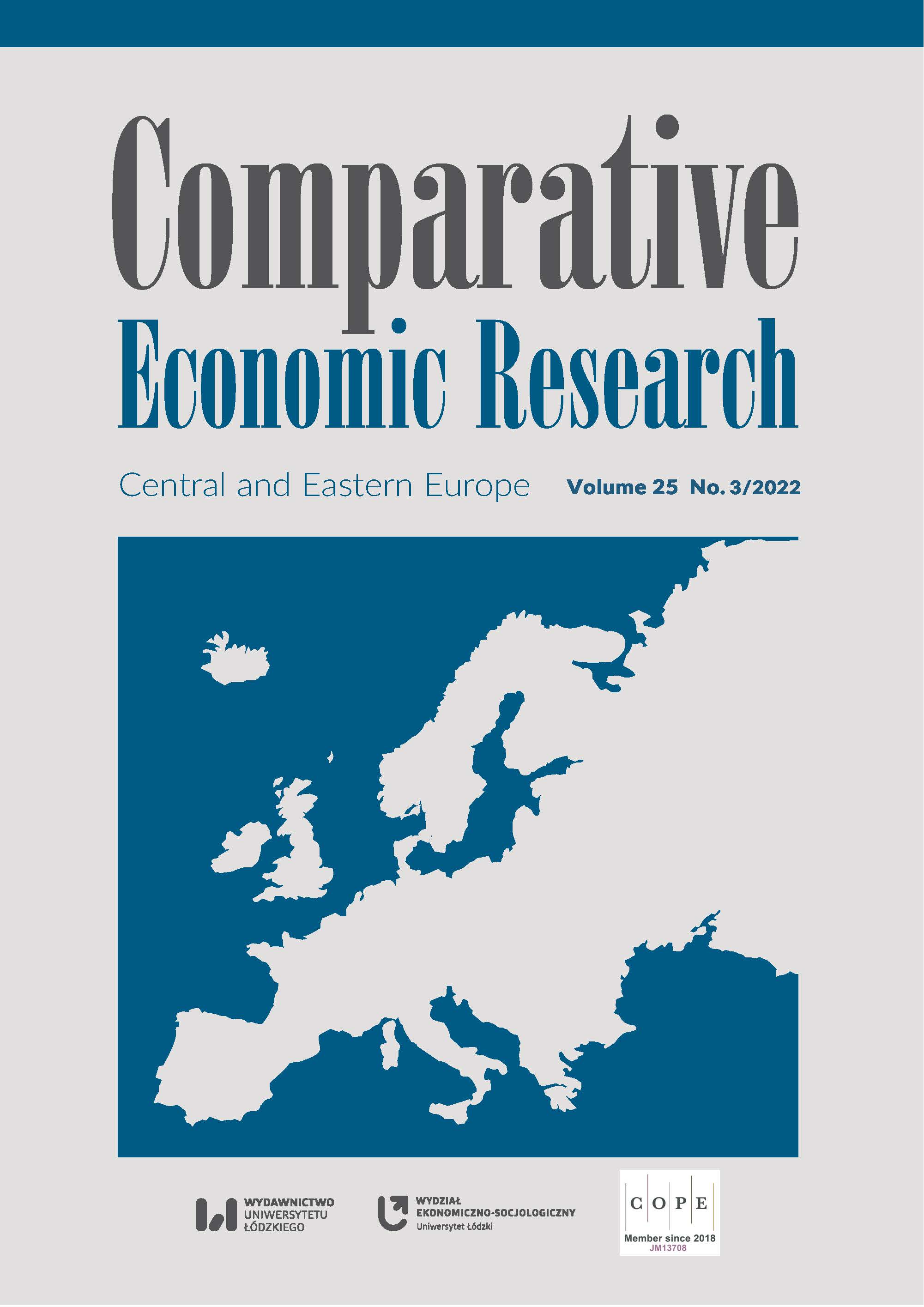A Comparison of the Effects of Capital and Labour Taxes in CEE Countries
DOI:
https://doi.org/10.18778/1508-2008.25.20Keywords:
capital tax, labour tax, CEE countriesAbstract
The aim of the article is to quantify and compare the impact of capital and labour tax on the economies of Central and Eastern Europe (CEE). The impulse‑response functions presented in the paper show that output reacts differently to changes in the taxation of labour and capital. Although there is some heterogeneity in the magnitude and persistence of tax effects between the analysed CEE countries, the simulations generally indicate that the negative impact of increased capital taxation on GDP is stronger than for labour taxation. More importantly, however, the negative effects of higher taxation on capital are more persistent than in the taxation of labour. This is largely because higher capital taxation strongly reduces savings and the desired stock of capital, which has important long‑term macroeconomic consequences.
Downloads
References
Adolfson, M., Laseen, S., Linde, J., Villani, M. (2007), Bayesian estimation of an open economy DSGE model with incomplete pass‑through, “Journal of International Economics”, 72 (2), pp. 481–511, https://doi.org/10.1016/j.jinteco.2007.01.003
Google Scholar
DOI: https://doi.org/10.1016/j.jinteco.2007.01.003
Alinaghi, N., Reed, W.R. (2021), Taxes and Economic Growth in OECD Countries: A Meta‑analysis, “Public Finance Review”, 49 (10), pp. 3–40, https://doi.org/10.1177/1091142120961775
Google Scholar
DOI: https://doi.org/10.1177/1091142120961775
Angeloni, I., Coenen, G., Smets, F. (2003), Persistence, the transmission mechanism and robust monetary policy, “Scottish Journal of Political Economy”, 50 (5), pp. 527–549, https://doi.org/10.1111/j.0036-9292.2003.05005006.x
Google Scholar
DOI: https://doi.org/10.1111/j.0036-9292.2003.05005006.x
Ardagna, S. (2001), Fiscal Policy Composition, Public Debt, and Economic Activity, “Public Choice”, 109, pp, 301–325, https://doi.org/10.1023/A:1013021004195
Google Scholar
DOI: https://doi.org/10.1023/A:1013021004195
Barro, R. (1974), Are Government Bonds Net Wealth?, “Journal of Political Economy”, 82 (6), pp. 1095–117, https://doi.org/10.1086/260266
Google Scholar
DOI: https://doi.org/10.1086/260266
Baxter, M., King, R.G. (1993), Fiscal Policy in General Equilibrium, “The American Economic Review”, 83 (3), pp. 315–334, https://www.jstor.org/stable/2117521 (accessed: 1.09.2021).
Google Scholar
Calvo, G.A. (1983), Staggered Prices in a Utility‑Maximizing Framework, “Journal of Monetary Economics”, 12 (3), pp. 383–398, https://doi.org/10.1016/0304-3932(83)90060-0
Google Scholar
DOI: https://doi.org/10.1016/0304-3932(83)90060-0
Christiano, L.J., Eichenbaum, M., Evans, Ch. (2005), Nominal Rigidities and the Dynamic Effects of a Shock to Monetary Policy, “Journal of Political Economy”, 113 (1), pp. 1–45, https://doi.org/10.1086/426038
Google Scholar
DOI: https://doi.org/10.1086/426038
Dixit, A.K., Stiglitz, J.E. (1977), Monopolistic Competition and Optimum Product Diversity, “The American Economic Review”, 67 (3), pp. 279–308, https://www.aeaweb.org/aer/top20/67.3.297-308.pdf (accessed: 1.09.2021).
Google Scholar
Fernandez‑Villaverde, J. (2010), The econometrics of DSGE model, “NBER Working Paper Series”, No. 14677, National Bureau of Economic Research, Cambridge, https://doi.org/10.3386/w14677
Google Scholar
DOI: https://doi.org/10.3386/w14677
Ferroni, F. (2010), Did Tax Policies Mitigate US Business Cycles?, “Banque de France Working Paper”, No. 296, https://doi.org/10.2139/ssrn.1693811
Google Scholar
DOI: https://doi.org/10.2139/ssrn.1693811
Greenwood, J., Hercowitz, Z., Huffmann, G.W. (1988), Investment, Capacity Utilization and the Real Business Cycle, “American Economic Review”, 78 (3), pp. 402–417, https://www.jstor.org/stable/1809141 (accessed: 1.09.2021).
Google Scholar
King, R.G., Rebelo, S.T. (2000), Resuscitating Real Business Cycles, “NBER Working Papers”, No. 7534, National Bureau of Economic Research, Cambridge, https://doi.org/10.3386/w7534
Google Scholar
DOI: https://doi.org/10.3386/w7534
McGrattan, E.R. (1994), The macroeconomic effects of distortionary taxation, “Journal of Monetary Economics”, 33 (3), pp. 573–601, https://doi.org/10.1016/0304-3932(94)90044-2
Google Scholar
DOI: https://doi.org/10.1016/0304-3932(94)90044-2
Mertens, K., Olea, J.L. (2018), Marginal Tax Rates and Income: New Time Series Evidence, “Quarterly Journal of Economics”, 133 (4), pp. 1803–1884, https://doi.org/10.1093/qje/qjy008
Google Scholar
DOI: https://doi.org/10.1093/qje/qjy008
Ohanian, L. (1997), The Macroeconomic Effects of War Finance in the United States: World War II and the Korean War, “The American Economic Review”, 87 (1), pp. 23–40, https://www.jstor.org/stable/2950852 (accessed: 1.09.2021).
Google Scholar
Owen, Z. (2019), Tax Cuts for Whom? Heterogenous Effects of Income Tax Changes on Growth and Employment, “Journal of Political Economy”, 127 (3), pp. 1437–1472, https://doi.org/10.1086/701424
Google Scholar
DOI: https://doi.org/10.1086/701424
Romer, Ch., Romer, D. (2010), The Macroeconomic Effects of Tax Change: Estimates Based on a New Measure of Fiscal Shocks, “The American Economic Review”, 100 (3), pp. 763–801, https://doi.org/10.1257/aer.100.3.763
Google Scholar
DOI: https://doi.org/10.1257/aer.100.3.763
Ruge‑Murcia, F.J. (2007), Methods to estimate dynamic stochastic general equilibrium models, “Journal of Economic Dynamics and Control”, 31 (8), pp. 2599–2636, https://doi.org/10.1016/j.jedc.2006.09.005
Google Scholar
DOI: https://doi.org/10.1016/j.jedc.2006.09.005
Taylor, J. (1993), Discretion versus policy rules in practice, “Carnegie‑Rochester Conference on Public Policy”, 39, pp. 195–214, https://doi.org/10.1016/0167-2231(93)90009‑L
Google Scholar
DOI: https://doi.org/10.1016/0167-2231(93)90009-L
Downloads
Published
How to Cite
Issue
Section
License

This work is licensed under a Creative Commons Attribution-NonCommercial-NoDerivatives 4.0 International License.











